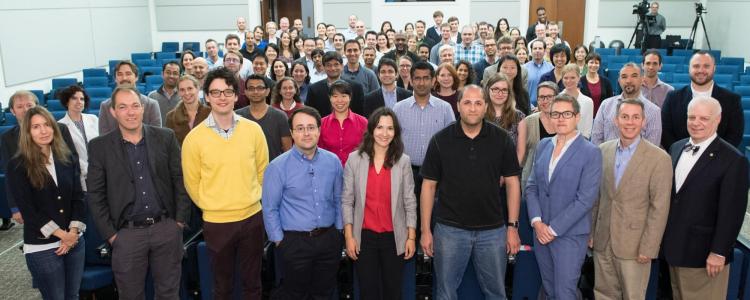CU on the Frontiers of Engineering

A group shot of the Frontiers of Engineering attendees. Bobby Braun is in the front row, second from the right, and Khurram Afridi is in the center of the third row.
For electric vehicles to become mainstream, Khurram Afridi thinks they need more advanced batteries and faster charging times. So the assistant professor of electrical, computer and energy engineering is developing ways to power vehicles wirelessly while they’re in motion. No need to plug in or even park – just cruise down the “charging lane” of the highway.
That innovative thinking landed him a speaking invitation to last week’s U.S. Frontiers of Engineering symposium, hosted by the National Academy of Engineering. The annual event brings together young engineers, ages 30-45, who are doing “exceptional research and technical work” across industry, academia and government.
Afridi said the interdisciplinary focus of the conference made it one of the most interesting he’d ever attended. For instance, after his presentation, he was approached by autonomous vehicle researchers who hadn’t been following advances in power electronics.
“Together, we were creating a vision of a transportation system that was completely hands-free and good for the environment,” he said.
Overall, CU Engineering was well-represented at the symposium – Dean Bobby Braun chaired the event, and former computer science faculty member Jordan Boyd-Graber presented on machine learning advances he made during his time at CU.
Two other CU Engineering faculty members also attended as general participants. Wil Srubar from civil, environmental and architectural engineering and Xiaobo Yin from mechanical engineering were among only 83 U.S. researchers chosen for the honor.
Srubar said he was thrilled to gain insights into so many cutting-edge fields, adding that he connected with researchers who are exploring new ways to use lichens in the built environment.
“Over the past few years, my core materials research program has transitioned from working on materials that are biologically inspired to materials that are truly biological and, in some cases, living,” he said. “It was exceptionally inspiring to interact with researchers who work routinely with biological systems in fields like medicine and biomolecular engineering.”
The symposium also inspired new collaborations for Yin, who plans to work with neuroscience and quantum computing researchers on a project in adaptable neuromorphic computing – essentially, making computers work more like a human brain.
“This was different from any conferences I had been to, whether it was big ones with diverse topics or small ones with concentrated and closely related community,” Yin said. “This one embraces topics that are, to certain degree, totally irrelevant to my own research, but extremely inspiring and intense.”
Emily Adams is a communications specialist for the College of Engineering & Applied Science.

